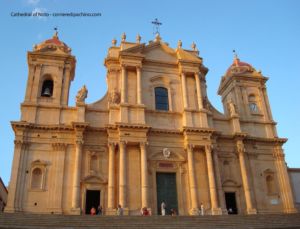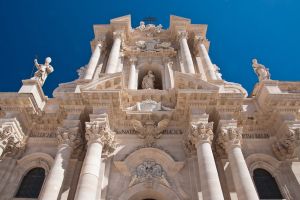
In southeastern Sicily, the Noto Valley was included in the UNESCO World Heritage List in 2002 because of its magnificent late Baroque cities. The eight Baroque cities of this area – Caltagirone, Militello, Catania, Modica, Noto, Palazzolo, Ragusa, and Scicli – already existed in Medieval times, but they were rebuilt, in part or entirely, after 1693 in the predominant style of the time. 
Known in ancient times by the name Ibla, Ragusa has two distinct city centers, one rebuilt after 1693 and the other reconstructed following the old Medieval model. The Baroque style in Ragusa is represented by nine main churches (among which the Chiesa di San Giovanni Battista, the Chiesa di San Giorgio, and the Chiesa Santa Maria dei Miracoli) and seven “palazzi” (among which Palazzo della Cancelleria, Palazzo Bertini, and Palazzo Cosentini).
Palazzolo and Modica also have two city centers. In Palazzolo the first is the Medieval center, around which the city was reconstructed after the earthquake. The ‘new town’ later developed around another city center. Particularly noteworthy are the churches of San Sebastiano and of the Santi Pietro e Paolo. Modica is also a town of rare beauty, with the old city center perched on a hill of the Iblei mountains, the new center is instead built in the valley. Among the monuments of the city, particularly noteworthy are the Cattedrale di San Giorgio and the Chiesa di San Pietro.
Caltagirone, too, has strong ties between pre- and post-earthquake construction. Its sumptuous architecture and the beauty of its facades is evident in churches such as Santa Maria del Monte or San Giacomo Apostolo, and in “palazzi” such as the Corte Capitanale and the Civic Museum. Militello in Val di Catania has a very peculiar pre-1693 city plan which was copied faithfully in the late-baroque reconstruction (see the churches San Nicolò and Santa Maria della Stella).
Noto was instead rebuilt on an entirely new site, also on two levels. The newer part, on a slope, has a series of buildings and streets in Baroque style (see Palazzo Ducezi or the San Nicolò Cathedral). Catania was also rebuilt from scratch, a true late-baroque jewel with its splendid Piazza del Duomo and the beautiful Via dei Crociferi.
Finally, the last late-baroque jewel of the Noto Valley is beautiful Scicli, where churches and villas form an astounding urban panorama. In particular, the decoration of the façade of Palazzo Beneventano is of great artistic and architectural import.

